The largest marine research station on the Great Barrier Reef is set to shift to a cleaner energy source, with solar generation and storage to meet most of its electricity needs.
The University of Queensland’s Heron Island Research Station – internationally renowned for coral reef and ecological research – will install an integrated microgrid system including roof top solar panels and battery storage facilities.
Project manager Danielle Shaffer said wind generation was not an option due to the 100,000 migrant and resident birds who live on or visit the island over the course of the year.
“Instead, high-efficiency solar panels will be installed on 22 rooftops, and at peak power they will produce more than four times the energy needed by the research station,” Ms Shaffer said.
“The surplus energy will charge the battery for use once the sun goes down.”
The system is expected to be operational mid-next year, delivering more than 80 per cent of the facility’s annual energy needs and ending the station’s reliance on diesel-generated power from the island’s resort.
Heron Island is a national park, 80 kilometre north-east of Gladstone, and is significant nesting location for two turtle species.
“On Heron we have research and education facilities including scientific equipment rarely found outside large mainland laboratories,” Ms Shaffer said.
 “We can have up to 150 visitors working on the island, so we were keen to ensure they have a reliable energy supply while doing what we can to protect this remarkable part of the world.”
“We can have up to 150 visitors working on the island, so we were keen to ensure they have a reliable energy supply while doing what we can to protect this remarkable part of the world.”
The batteries are expected to power the Research Station overnight until about 2am, with integrated diesel generation kicking in until sunrise.
Future energy efficiency measures will be aimed at reducing the station’s overnight load to extend this switchover, reducing the runtime of the diesel generators even further.
UQ has engaged juwi Renewable Energy to install the system, and work has been scheduled to reduce impact on wildlife.
The capacity of the modular vanadium redox flow battery, which will be recyclable after its 20 year life, could be increased as unit prices reduce in the future.
Senior Manager of the Station, Dr Clint Chapman, said that he hopes the project will be a proof of concept for other organisations looking to embrace renewable energy.
“This is a demonstration – particularly to businesses in remote and marine environments – that renewables are a cost-effective option and should seriously be considered over solely fossil fuel generated power,” he said.
“We’re still at the start of the solar revolution, and I’m excited that UQ can help showcase solar power in action for the rest of the world.”
UQ announced plans earlier this year to become the first university in the world to generate 100 per cent of its electricity from its own renewable asset, with plans to acquire a solar farm at Warwick on Queensland’s Southern Darling Downs.








